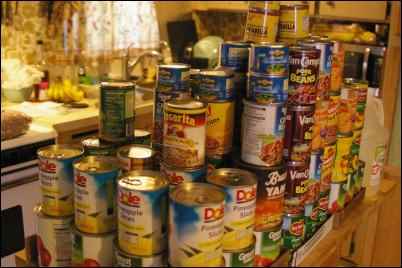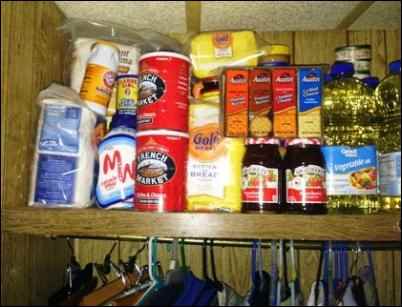“Honey, did you pay the electric bill?”
“Yes, I paid it.”
“Then why did the electricity go off?”
“Look outside and see if the streetlamps are off.”
“Yes, the streetlamps are off and all the other houses are dark as well.”
“The lights will probably come back on in a few minutes. Why don’t you call it in to the electricity company.”
“OK… Honey, my cell phone isn’t working. Try yours.”
“That’s strange.”
“Turn on the TV and see what’s going on.”
“Hey Dummy, there’s no electricity, remember?”

Tonight, Earth might be hit by a large solar magnetic event. It’s highly unlikely to be strong enough to cause a nationwide blackout that will last for 1-4 years… But the chances of such an event happening in your lifetime are 25%. According to scientists, there is a 7%-12% chance of such an event in the next 10 years.
In 1989, electricity across Quebec, Canada and the Northeastern U.S. was blacked out by a solar flare.
In 1994, two Canadian telecommunication satellites were disabled by solar activity. One recovered in a few hours, the other took 6 months and $50 million to fix.
FAA’s GPS-based Wide Area Augmentation System was out for 30 hours in 2003 due to space weather.
None of these were anywhere near the size of the 1859 Carrington Solar Superstorm which created fires in telegraph offices. Over 150 years seems like a mighty long time to worry about something like this happening again, and even though the solar flare caused telegraph wires to spark, who cares?
In 1859, the solar flares that occurred in 1989, 1994, and 2003 would never have been noticed, because there were no electrical grids or satellites to disrupt. Today they are ubiquitous. We can’t live without them. Every ATM transaction, telephone call, and corporate communication requires satellites and electrical grids.
But how likely is another solar flare of that size? In July of 2012, a Carrington-sized solar storm crossed Earth’s path TWO WEEKS before the Earth was due to be in that exact position. We missed the total blackout of Earth (which would last at least a year) losing all communication, refrigeration, light, electric heat, and AC, all of our jobs, access to all the money in the banks, and pretty much everything else society depends on by only two weeks.
Solar flares are benign to humans. Prior to telegraph wires being strung from city to city in the mid-1800s the only evidence of such events would have been extreme Aurora Borealis lights viewable farther south than usual. With each passing year, Western society depends more and more on sensitive infrastructure. In 1921, an event that was much smaller than Carrington caused widespread radio outages and fires in telegraph offices. Not much of a deal, but according to a study in 2008, if the same storm occurred today it would “result in large-scale blackouts affecting more than 130 million people and would expose more than 350 transformers to the risk of permanent damage.”

The real problem is the transformers—particularly the large, utility distribution transformers. They are especially vulnerable to a large-scale event. If they are blown out in large numbers, there aren’t enough in stock to replace them all. Not hundreds for sure. These transformers are GROUNDED to protect them from lightning strikes. In a geomagnetic storm, Earth’s magnetic forces interacting with the passing charged solar energy cause a surge of electricity to COME FROM THE GROUND. In other words, the exact mechanism that protects these million-dollar transformers from disaster will be the CAUSE of their doom in a Carrington-sized solar storm.
We aren’t talking about the little transformers you see on the pole outside or even the bigger transformers you see on the ground sometimes. Multi-million-dollar, building-sized, custom-built transformers that take months to build and install are what we’re talking about. Imagine if hundreds of them failed at the same time…
But there are other dangers.
This doesn’t even mention the multiple airline groundings due to “software error” at both the airlines and the national air-traffic-control headquarters or the suspension of the Dow Jones stock market that all occurred in 2015 with little to no explanation. Was it a cyber attack, human error, or simply bad luck?
The problem isn’t that the risks of bad things happening has changed. The problem is that everything is interconnected, and we are so dependent that the consequences of a systemic failure to you, personally, have increased exponentially over the risk to your great-grandparents. What did they care if the telegraph wires burned up? It had little effect on their daily lives. Alternately, what do you care if the banking system collapses and you can’t get to any of your money for six months? Big difference.
Risk assessment involves two primary variables. Variable #1 is the likelihood of the event. Variable #2 is the impact of the event. What is the likelihood of a Carrington-sized solar flare shutting off power to the U.S. for months or years? It’s very low for any given year. Less than 1% probably. However, what would the impact of such an event be for you, personally, and your family? It could be deadly.
Let’s look at another likely crisis… a flat tire on your car. What is the likelihood that you will get a flat tire on your car at some point in your lifetime? Probably 100%. Now, what is the impact of such an event? A little inconvenience. Even though a flat tire is highly likely—and you should have a spare tire and roadside assistance, or the tools and knowledge to change it—the event will not change your life. An event like a Carrington-sized solar flare, however, will change life on Earth as we know it for months if not years.
As a prepper, I’m more worried about risks to our electric grid than most other threats. The likelihood of war in the U.S. is very low, for instance. Or the likelihood of a complete collapse of the U.S. governmental system. These types of events take a very long time to develop and you could see them coming far in advance.
Yet, most of us have experienced that sound of the electricity shutting off in our home from a blackout. A sudden sound of everything turning off at once then silence, darkness, and a small amount of rising fear as the air gets still and stuffy. Analysis of Superstorm Sandy in New York and hurricanes Katrina, Rita, and Wilma showed that the average time it took to restore electricity to 95% of affected customers after a regional storm was 11-14 days, with many customers losing power for over 21 days.
News video showed “cellphone zombies” wandering the streets of New York looking for someplace to plug in their cellphone to charge. Everyone learned that if you’re not already prepared before you hear the click and the power shuts off then you will experience panic, confusion, and unnecessary suffering. Imagine if you went and turned off the electrical breaker to your house and left it off for 14 days. Now imagine it was off for your entire region. No restaurants, no grocery stores, no gasoline pumps, no banks or ATM or electronic transactions, no communications or TV, no running water, no sewage, no reason to go to work, no paycheck. Just you and your family sitting in the dark and heat or cold with whatever food, water, and protection you happened to have on hand the instant the lights went “click.”
In 2006, the National Geographic Channel released a docu-drama entitled “American Blackout” which shows in gritty detail what would happen in a national, extended blackout. The National Geographic Channel also has an entire section of their website set up to discuss the various topics related to such a blackout.
An extended nationwide blackout could be caused by a large solar flare, an EMP attack by as few as two nuclear warheads set off on the edge of space above America, or a successful cyber-attack on the power grid. While these events are highly unlikely, so was the likelihood of both World Trade Center towers being completely demolished by a terrorist attack, two space shuttles (carefully watched over by thousands of highly trained engineers) blowing up, or the flooding of the entire city of New Orleans with no meaningful response for days causing well over 1,000 deaths.
What was the likelihood of a deadly earthquake and tsunami in Indonesia killing nearly 250,000 people and displacing over 1.75 million more followed just a few years later by another earthquake and tsunami in Japan that killed nearly 2,000, displaced 250,000, and caused a catastrophic nuclear meltdown? The low likelihood of an event does not mitigate the devastating consequences the event unleashes. If you are one of the 100+ million victims of a national or regional power-grid disaster you will want to be prepared.
So, all I’m saying is… HAVE A YEAR’S SUPPLY OF FOOD STORED… If not a year then six months, if not six months then three months. It’s really not as hard as you may think.
The lights can go out at any time without warning and not come back on for weeks, months, years. It is possible.
These pictures show what $202 worth of non-perishable food and some personal hygiene looks like.
156 items for just $202. Average cost $1.29.
How many times have we taken the family out for a meal or an evening’s entertainment for more than $200? Is there anything in these pictures that you wouldn’t use in a year? Anything you wouldn’t want to eat? How long can you live on 20 pounds of beans, 10 pounds of pasta, 40 tomato products, 40 fruit products, 35 vegetable products, 3 jars of pickles, 4 jars of salsa, refried beans, pork and beans, sauerkraut, 4 pounds of salt, 10 bars of soap, 3 tubes of toothpaste?
For me, this is just what I decided to buy this morning (for no particular reason). Add to that the multiples of syrup, ranch dressing, mayo, pancake mix, bread flour, other flour, yeast, oil, mac & cheese, jelly, peanut butter, spaghetti sauce, ketchup, rice, canned meat, etc., and you start to have something like a home food-storage solution.
Add to that 100 pounds of hard, white-winter wheat, 75 pounds of sugar, an additional 80 pounds of long-term-storage rice, 20 pounds of long-term-storage oats… and now you’ve really got something. Add a goat for milk and chickens for eggs to make it complete.
Here is a simple exercise. Go look in all of your drawers, the car(s), and in the cracks of the sofa and chairs for lost change. Now gather up all the spare $1 and $5 bills sitting around your house. Get all the change sitting on the clothes dryer. None of this will be missed if you spend it. How much did you gather? Every six months or so I do this and I generally get around $50.
How much pasta and dried beans can you buy for $50? Or how many cans of beans and vegetables can you buy for $50?
Everyone starts somewhere. There are many online resources that discuss emergency food preparation, emergency water storage, emergency energy storage, and personal protection in the event of a disaster. The good news is that there probably won’t be a crippling disaster tomorrow… but there might be. There is almost zero chance of anything bad happening on any given day, yet every single day bad things happen. The question is: Do you care? Some people don’t. They figure, “It will all work out.” I, personally, prefer to be prepared. Below are some preparations that I chose to do:
Keep emergency cash in your car and on your person somewhere other than your wallet or purse. I wear a necklace with a micro-flashlight, a small knife, and $100 wrapped up in a tube. I also keep the cost of a tank full of gasoline in my glove compartment at all times. My greatest fear is getting 200 miles down the road and stopping to fill up only to realize I lost or forgot my wallet. Now I’m stranded for no reason whatsoever. Doing this costs NOTHING. It’s simply cash.
Fill at least one closet shelf with extra food. Clear out the top shelf of a closet and fill it up with rice packets, cans of food, tuna fish, extra spaghetti sauce, peanut butter and jelly, bags of bread flour or beans, and jars of pickles. Whatever you eat regularly, buy extras. This shelf of food might cost you $100. But it’s $100 that you will use. This is food that you will eat. You are just keeping extra.
Store water. Each adult needs at least one gallon of water per day (kids need some water too, I hear). How you store this water is based on your situation. If I lived in an apartment I would store gallon bottles or 5-gallon cubes in a closet. If I had the space, I would get a clean 55-gallon drum and fill it up with water, maybe more than one. I, personally, use 275-gallon IBC cubes to store my emergency water. I have two, so I always have at least 500 gallons of emergency water. I also keep at least three cases of bottled water on hand. Some water storage is better than no water storage. Store some. You don’t want to be drinking water from the back tank of the toilet in order to stay alive.
Think about energy. I live on a homestead so I have a 250-gallon propane tank, a 250-gallon gasoline tank, and a 1,000-gallon diesel tank. When I lived in the suburbs I would keep at least three extra 25-pound propane tanks for my outdoor grill, and at least 30 gallons of gasoline stored in safe 5-gallon containers. That way, I always had some fuel to cook and at least a tank full (or two) of gasoline on hand. Another energy you might want to store is firewood. The storage containers cost money, but the fuel is essentially free, because you will use it! You want to cycle through your stored gasoline every 3-6 months.
Toiletries, medicine, candles, flashlights and batteries, emergency radio, self-defense weapons, and ammo. These are all very important preparations for a power outage (short-term or long-term). You don’t have to be a “prepper” in order to be prepared. For the entirety of human history, people have stockpiled what they needed for the winter, for whatever. It has only been in the last 70 years that we have decided to live hand-to-mouth with constant trips to Walmart and Chili’s.
Since Americans eat out so much—grabbing a drive-thru breakfast on the way to work, then eating lunch out, and ordering a pizza for dinner—we have almost NO FOOD at home. In the past, people would have a pantry full of commodities like dried beans and rice. You would be hard-pressed to find more than 2 pounds of rice in an average American household today and probably no dried beans whatsoever. If you don’t purposefully create emergency food storage then you are pretty much guaranteed to have none at all in an emergency.
Imagine how long just 25 pounds of rice would feed you; 25 pounds of rice is the size of your pillow and will store for years (if you keep it away from mice). Rice, beans, tuna fish, peanut butter, bags of sugar and flour, two large boxes of instant pancake mix, plus 6 bottles of syrup, 5 containers of oats, 10 jars of spaghetti sauce, 10 pounds of spaghetti, extra vegetable oil, extra boxes of cereal, 20 rolls of toilet paper, batteries. Most of this you will use eventually. Maybe not the rice and oats, but they are super cheap and will keep you alive in a long-term emergency.
You don’t need to go buy $1500 worth of “Powdered and Freeze Dried Emergency Storage Food”. In fact, I recommend against it. Just buy extra of what you already eat first. Like peanut butter, pancake mix, spaghetti, and pickles. Then add some bulk staples that you probably won’t use on a daily basis but will save you in an emergency, like lots of extra rice and dried beans pasta. Put them in 5-gallon plastic buckets at the bottom of your closet.
Don’t buy anything exotic, like MREs or freeze-dried meals, without testing and tasting them first. I, personally, can eat MREs for three meals a day because I was in the Army. I like them. But most powdered foods give me diarrhea because I’m lactose intolerant and they use lots of powdered milk. Many of these ready-made emergency foods are very expensive and taste bad! It’s easier and cheaper to just buy 24 packets of Knorr Rice Sides than a big bucket of “Emergency Ration Rice and Cheese.”
Go find some spare change and buy something with it today. Put some extra cash in your car for emergencies today. Fill a container with water that you can drink in an emergency today. Clear out a shelf in a closet for food storage today. If you create the space for food and water storage then I guarantee it will fill itself up over time. Nature abhors a vacuum. You will find ways to fill that space with emergency supplies that you can use anytime.
Be prepared. Stay Alive.















Some good observations, and you don’t have to be a full blown “prepper” to understand the wisdom of being prepared. For instance: try being the very last house on the electrical grid (as we are) – anything happens and we’re out of power for a minimum of 3 days. Your situation really dictates what you need – our ultimate food source is out back under the dock 24/7 – so we’re lighter on the canned meats side, etc. Good article.
Yep!
To some, this articlemight seem radical, a bit over the top, but I agree with the author that storing extra food, water, and other emergency supplies is a good idea.
Good ideas BUT you can’t just stick the stuff on a shelf and forget about it.
#1 – put ALL pasta, rice, oats, cereal, flour, sugar in totes, buckets, not just in ziplock bags. You will be getting free protein with bugs, and/or mice. Flour needs in containers with a bay leaf added, again – bugs
#2- you need to use any item that is close to the use by date and get new ones
I typically use mylar bags with an oxygen absorber for long term storage. This will extend the life quite a big. The fastest thing to get bugs is flour (in my experience). If I’m storing 5 lb bags of flour for just a year or 2 then I put them in large ziplock bags and rotate them though my normal use. If I’m storing for longer then I use mylar bags and oxygen absorbers. Putting them in buckets helps with larger pests like mice. It also make it easier to move around. Put a list of what is in the bucket on the outside.
For my really long-term storage that will only be used in a long-term emergency I use larger mylar bags (5 gallon) and use dry ice (put a small chunk in the bottom) instead of oxygen absorbers. Food has been stored without all of this for generations, so it’s a choice. I don’t know anything about bay leaves.
Bad food smells bad, typically. If you have a mold allergy then long term storage is more of an issue. For instance, I will buy Krusteaz pancake mix in the plastic packaging and store it for years without worrying about using it. But if I had a mold allergy and used it after 5 years and there was some unknown mold then I could get really sick. Generally the more “whole” the food is the longer it lasts. However white rice stores longer than brown rice, because brown rice has the oil still in it. I think I currently have over 600 lbs of stored rice, 250 lbs of beans and 400 lbs of other various dry goods plus 50+ lbs of canned meats. I buy canned vegetables instead of making my own. And rotate your stock.
I slightly disagree on the use by date. Most things have “best by” dates which aren’t the same and i’ve been told that nothing can have a use by date past 2 years (due to 1 state law that everyone adheres to). I would be happy eating rice that has been properly stored for 5 or even 10 years. I’ve used flour after 4 years that was properly stored. My generally feeling is that if it’s a true food emergency then having it is better than not having it. I’m not easily worried about most things.. Every time I’ve had “food poisoning” or anything like it I got it from a restaurant meal not from 3 year old pork that I canned myself and sat on a shelf.
Great comments. Thanks.
Actually most non perishables properly stored can last far beyond their due dates. Anything in cans (except tomato and other acidic products) can last numerous years. Tomatoes and high acid products will start degrading their packaging within 4-5 years after their “expiry date” . You would really be very surprised. Also home canned goods if the seal is good are fine for years. I had home canned carrots (water bath) from 2010 that lasted until 2020 just as fresh as the day I canned them. The only reason I don’t eat the ones from 2010 anymore is I simply ran out. But it is good to eat the older stuff first.
another way to store oats, rice, dried beans, flour, corn meal is to “oven can”, sometimes called “dry Canning. put in canning jars, no lids or rings, place on cookie sheet (in case of spills), in 250 degree oven for 1 hour. The jars will be hot!! Take out one at a time, put on lid and ring, you will hear the “pop” indicating that it is sealed. I have done this for years, and recently finished a jar of flour that was canned four years ago….worked perfectly.
great info!